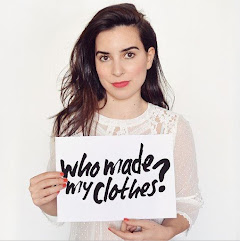Fashion Revolution Campaign
A Short Analysis of its Origins, Vision & Visual Identity
Reza Shirmarz

Click to watch the visual history of Fashion Revolution Campaign
Fashion Revolution Vision
FRC seeks to end the human and environment exploitation in the global fashion industry, create a more humane workplace and vocational conditions for the workers of the garment industry as well as fashion industry across the world, increase the level of workers earnings on a monthly basis, establish an global balance of power in fashion industry, run and lead a more effective global campaign in the industry, aid the international fashion industry not to harm or waste natural resources in order to produce clothes, etc. and enrich the ecosystems to a great extent, assist to create a more transparent and responsible fashion industry, decrease the level of used clothes throwaways, and encourage the fashion industry producers to produce clothes with a longer life and dump less, and to establish workplaces where work experience and local minds are genuinely respected by the existing fashion industry.
Organizational Identity
On the one hand, organizational identity is about the different, unique and ongoing character of a company or organization. On the other hand, organizational identity comes from the plural beliefs and emotions which affects the members of an organization and shapes eventually their actions. The shared beliefs among the stakeholders of Fashion Revolution are curiosity, creativity, eagerness, optimism, idiosyncrasy, diversity, multiplicity, scepticism, learning-based research.
Visual Identity
The visual identity of Fashion Revolution campaign refers to its logo, typography, colors, gradients, graphic patterns, quotes, stats, photography, textures, edits, overlays, icons and emojis and illustrations which are included in the following video:
Click to watch the video
Farid, A. (2013), Bangladesh Building Collapse Kills At Least 123, Injures More Than 1000, CNN World, Retrieved From https://edition.cnn.com/2013/04/24/world/asia/bangladesh-building-collapse/index.html
Flake, D. F. (2015), Image is Everything: Corporate Branding
and Religious Accommodation in
Workplace, University of Pennsylvania Law Review, V. 163, N. 3, pp. 699-754.
Juflikar, M. and Jim, Y. (2013), Building Collapse in Bangladesh Leaves Score Dead, The New York Times, Retrieved from https://www.nytimes.com/2013/04/25/world/asia/bangladesh-building-collapse.html?hp
Kent, S. (2019, May 2), Why Fashion Doesn't Pay Fair, BOF, Retrieved from https://www.businessoffashion.com/articles/news-analysis/why-fashion-doesnt-pay-fair
https://www.fashionrevolution.org/about/
https://www.fashionrevolution.org/about/transparency/
https://www.fashionrevolution.org/blog/
Nelson, D. (2013), Bangladesh: UK rescue aid rejected after Dhaka factory collapse, The Telegraph, Retrieved from https://www.telegraph.co.uk/news/worldnews/asia/bangladesh/10024004/Bangladesh-UK-rescue-aid-rejected-after-Dhaka-factory-collapse.html
Rauturier, S. (2018), What Is Fast Fashion? Good on you, Retrieved from https://goodonyou.eco/what-is-fast-fashion/



This is amazing. Thank you very much.
ReplyDeleteThanks for reading it.
DeleteI love this global campaign, thanks for writing on this. Fast fashion brands need to listen to such campaigns which are supported by millions of people across the world. We also should give them a hand in different ways to come up with practical ideas and solutions. Gluttonous brands must stop thinking only about the huge profits they make and join us to support the underpaid and overworked garment factory workers.
ReplyDeleteThanks, Kate. You're absolutely right.
DeleteI live in Bangladesh and I have seen how the famius brands exploit poor workers for their benefit... It's a real tragedy.
ReplyDeleteHi, Ali, could you share some more information about what's going on in Bangladeshi garment factories now? How the pandemic has undermined it?
DeleteOf course. I know that the pandemic has worsen the situation for the workers. Many of them have lost their jobs and the rest work part-time to win some bread for their families. But, overall, the garment industry here is the largest in the world and after the tragic collapse you mentioned in your post they industry decided to become more transparent and create better working conditions for the workers. Now more than 80% of Bangladesh's exports is produced in the garment factories, but Covid-19 still threatens this flourishing industry and its owners need to find reasonable solutions for a better future.
DeleteThanks for sharing the info.
DeleteNice presentation. It's our duty to stop buying from the fast fashion brands like Zara, Bershka, etc. It's really urgent. It's putting our planet in danger more and more...
ReplyDeleteWe should learn to prefer quality over quantity.
ReplyDeletefast fashion industry produces a lot of wear and tear. That's awful. We shouldn't cooperate...
ReplyDeleteCan't believe how unfair could our normal clothes shopping can be... to those you even don't know. This needs to be taken seriously be governments and we citizens. I hope so...
ReplyDelete